PCHAS_1032900 rhoptry-associated protein 1, putative (RAP1)
Disruptability [+]
| Species | Disruptability | Reference | Submitter | |
|---|---|---|---|---|
| P. berghei ANKA |
Refractory |
RMgm-1134 | Imported from RMgmDB | |
| P. berghei ANKA |
Possible |
PlasmoGEM (Barseq) | PlasmoGEM | |
| P. falciparum 3D7 |
Possible |
10835342 | Theo Sanderson, Wellcome Trust Sanger Institute | |
| P. falciparum 3D7 |
Possible |
USF piggyBac screen (Insert. mut.) | USF PiggyBac Screen | |
Mutant phenotypes [+]
| Species | Stage | Phenotype | Reference | Submitter |
|---|---|---|---|---|
| P. berghei ANKA | Asexual |
Attenuated |
PlasmoGEM (Barseq) | PlasmoGEM |
Imaging data (from Malaria Metabolic Pathways)
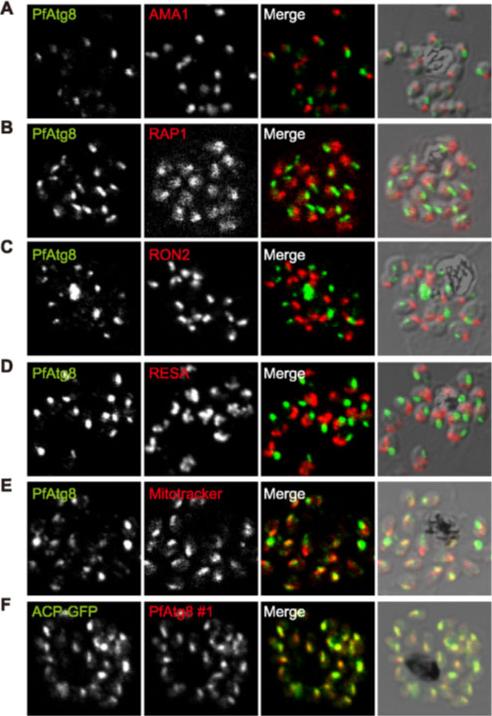
PfAtg8 localizes to the apicoplast. P. falciparum FCR3 (A–E) and P. falciparum 3D7 transfected with ACP-GFP (F–H) were stained with the indicated organelle markers and visualized by confocal microscopy (because ACP-GFP was not uniformly expressed, some merozoites displayed only faint GFP signals). Anti-PfAtg8 antibody #1 was used in (A–F), and anti-PfAtg8 antibody #2 was used in (G). Apical membrane antigen 1 (AMA1) as a microneme marker (A), rhoptry-associated protein 1 (RAP1) as a rhoptry body marker (B), rhoptry neck protein 2 (RON2) as a rhoptry neck marker (C), the ring-infected erythrocyte surface antigen (RESA) as a dense granule marker (D), MitoTrackerRed CMXRos as a mitochondria marker (E), ACPGFP (F–H) and the organellar histone-like protein PfHU (H) as an apicoplast marker were used. Scale bar, 1 mm.Kitamura K, Kishi-Itakura C, Tsuboi T, Sato S, Kita K, Ohta N, Mizushima N. Autophagy-Related Atg8 Localizes to the Apicoplast of the Human Malaria Parasite Plasmodium falciparum. PLoS One. 2012;7(8):e42977.
See original on MMP
The PfRON4 and PfRON5 proteins localize to the rhoptry neck. A, Antibodies raised against PfRON4 and PfRON5 recognize specific protein products in schizont parasite extracts. B, IFAs using the anti-PfRON antibodies reveal staining of the apical tip of free merozoite, in close apposition with the rhoptry bulb markers PfRAP1 and PfRAMA, suggesting a rhoptry neck localization. Scale bar: 0.2μm C, Immunoelectron microscopy confirms that PfRON 4 localizes to the rhoptry neck. Scale bar: 0.1μmRichard D, Macraild CA, Riglar DT, Chan JA, Foley M, Baum J, Ralph SA, Norton RS, Cowman AF. Interaction between Plasmodium falciparum apical membrane antigen 1 and the Rhoptry neck protein complex defines a key step in the erythrocyte invasion process of malaria parasites. J Biol Chem. 2010 285:14815-22
See original on MMP
PFF0645c is released from the rhoptries only after completion of merozoite invasion. (A) IEM of PFF0645c-HA merozoites pre and post-erythrocyte invasion labeled with immunogold anti-HA (white arrows). Scale bar = 0.2 mm. (B) Widefield 3D imaging of PFF0645c-HA merozoites labeled with anti-HA, anti-PfRON4 and DAPI showing early, mid and late invasion events. Scale bar = 5 mm. 3D reconstruction with 0.2 mm grid intervals. (C) Widefield 3D imaging of PFF0645c-HA early rings (,10 min post-invasion) labeled with anti-HA, anti-PfRON4 (,PVM) anti-RAP1 (PV) or anti-MSP1 (plasma membrane) and DAPI. Scale bar = 5 mm. 3D reconstruction with 0.2 mm grid intervals.Zuccala ES, Gout AM, Dekiwadia C, Marapana DS, Angrisano F, Turnbull L, Riglar DT, Rogers KL, Whitchurch CB, Ralph SA, Speed TP, Baum J. Subcompartmentalisation of Proteins in the Rhoptries Correlates with Ordered Events of Erythrocyte Invasion by the Blood Stage Malaria Parasite. PLoS One. 2012;7(9):e46160.
See original on MMP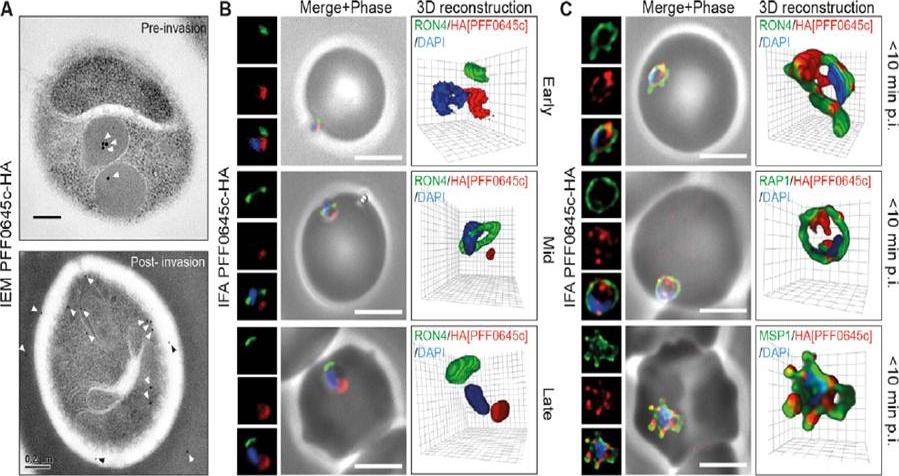
PFF0645c is released from the rhoptries only after completion of merozoite invasion. (A) IEM of PFF0645c-HA merozoites pre and post-erythrocyte invasion labeled with immunogold anti-HA (white arrows). Scale bar = 0.2 mm. (B) Widefield 3D imaging of PFF0645c-HA merozoites labeled with anti-HA, anti-PfRON4 and DAPI showing early, mid and late invasion events. Scale bar = 5 mm. 3D reconstruction with 0.2 mm grid intervals. (C) Widefield 3D imaging of PFF0645c-HA early rings (,10 min post-invasion) labeled with anti-HA, anti-PfRON4 (,PVM) anti-RAP1 (PV) or anti-MSP1 (plasma membrane) and DAPI. Scale bar = 5 mm. 3D reconstruction with 0.2 mm grid intervals.Zuccala ES, Gout AM, Dekiwadia C, Marapana DS, Angrisano F, Turnbull L, Riglar DT, Rogers KL, Whitchurch CB, Ralph SA, Speed TP, Baum J. Subcompartmentalisation of Proteins in the Rhoptries Correlates with Ordered Events of Erythrocyte Invasion by the Blood Stage Malaria Parasite. PLoS One. 2012;7(9):e46160.
See original on MMP
PTEX components are apically localised in merozoite dense granules. (A and B) Immunofluorescence assays were completed during schizogony and were probed for either PTEX components or markers of distinct organelles as indicated in each of the panels. (A) Merozoites probed with antibodies specific to both HSP101 and EXP2 demonstrate apical localization for both proteins. (B) Schizonts and merozoites were labeled with antibodies specific to HSP101 and either RESA (dense granules), AMA1 (micronemes) or RAP1 (rhoptries). Co-localisation quantitation reveals that HSP101 localises most closely with dense granule associated RESA (top two panels). Scale bar: 1μm. Bullen HE, Charnaud SC, Kalanon M, Riglar DT, Dekiwadia C, Kangwanrangsan N, Torii M, Tsuboi T, Baum J, Ralph SA, Cowman AF, de Koning-Ward TF, Crabb BS, Gilson PR. Biosynthesis, localisation and macromolecular arrangement of the Plasmodium falciparum translocon of exported proteins; PTEX. J Biol Chem. 2012 287(11):7871-84.
See original on MMP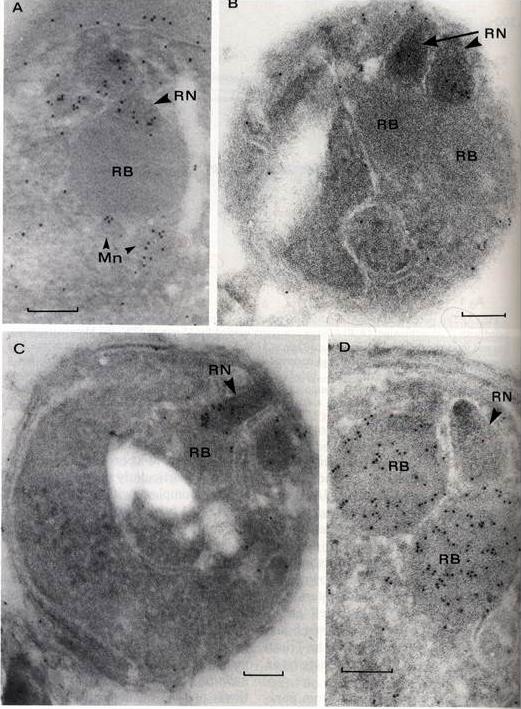
Post-embedding immunolableing of P. falciparum isolate FC27, with affinity-purified anti Ag352 antibodies to AMA-1 (A,B,C) and rabbit anti QF3 monoclonal antibody 7H8/50 to RAP-1 (D). Bars equal 100 nm. A. Maturing merozoites within a schizont showing gold particles over rhoptry neck (RN) and micronemes (Mn). B,C Free merozoites showing labeling of electron dense rhoptry necks (RN), no labeling over rhoptry bodies (RB), and sparse labeling of merozoite periphery. D. Immunolabeling restricted to the body of rhoptries (RB).Crewther PE, Culvenor JG, Silva A, Cooper JA, Anders RF. Plasmodium falciparum: two antigens of similar size are located in different compartments of the rhoptry. Exp Parasitol. 1990 70:193-206. Copyright Elsevier 2010.
See original on MMP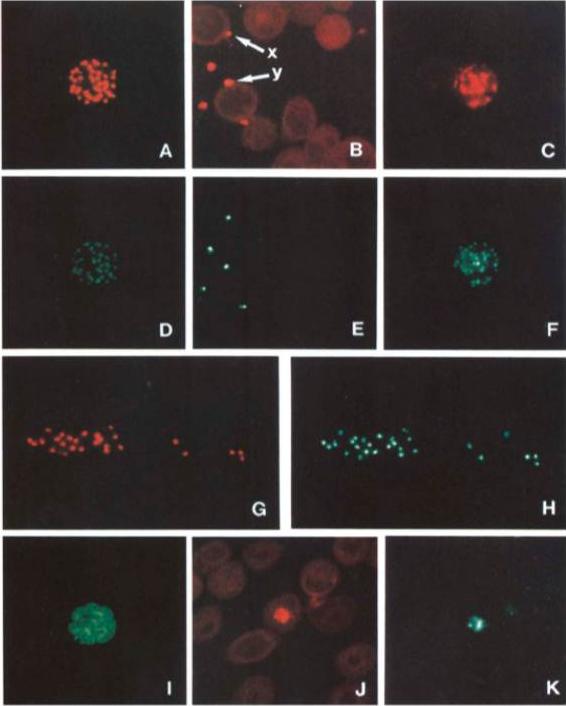
Single and dual immunofluorescent analysis of the subcellular localization of AMA-1, RAP-l and MSPl in mature schizonts, free merozoites, and ring stages of P. falciparum 7G8. Descriptors of the subcellular localization follow. Co-localized apical immunofluorescence of C-terminal AMA-1 and RAP-l in mature schizont, (A and D, respectively). Co-localized apical immunofluorescence of C-terminus-AMA-1 (x) and RAP-l in free merozoite, (B and E, respectively); surface localization of C-terminus-AMA-1 (y) and apical localization of RAP-l in free merozoite, (B and E, respectively). Co-localized apical immunofluorescence of N-termini-AMA-1 and RAP-l in mature schizont and free merozoite, (C, F and G, H, respectively). Surface localization of MSPl in mature schizont (I). Co-localization of C-terminus-AMA-1 and RAP-l in ring stage parasite, (J and K, respectively). Methanol-fixed schizont/ring stage thin films (ring development less than 3 h) were reacted with rat mAb IgG (25 pg ml-1), or rat mAb IgG and RAP-l culture supematant (dil. 15) in phosphate-buffered saline containing 1% foetal calf serum. Secondary stains were tetramethyl rhodamine isothiocyanate coupled or fluorescein isothiocyanate coupled anti-rat (A,B,C,G,J or I, respectively) and FITC coupled anti-mouse (human and rat adsorbed) (D,E,F,G and K).Narum DL, Thomas AW. Differential localization of full-length and processed forms of PF83/AMA-1 an apical membrane antigen of Plasmodium falciparum merozoites. Mol Biochem Parasitol. 1994 67:59-68. Copyright Elsevier 2009.
See original on MMP
Upper and right panels: Electron microscopy with immunogold labeling of RAP1 (white arrows). The scale bar represents 0.2 mm. (E) Electron microscopy of merozoite after invasion showing intact dense granules (white arrows and insets). The scale bar represents 0.2 mm. (F) Serial sections of electron microscopy with immunogold labeling of RAP1 10 min after invasion (white arrows). The scale bar represents 0.2 mm. RAP1 labeling revealed prominent extensions of the PV into the erythrocyte cytosol. Left bottom panel: Serial section electron microscopy with immunogold labeling of RAP1 showing colocalization of RAP1 with rhoptry-derived membrane into erythrocyte cytosol during an untreated merozoite invasion event. Riglar DT, Richard D, Wilson DW, Boyle MJ, Dekiwadia C, Turnbull L, Angrisano F, Marapana DS, Rogers KL, Whitchurch CB, Beeson JG, Cowman AF, Ralph SA, Baum J. Super-resolution dissection of coordinated events during malaria parasite invasion of the human erythrocyte. Cell Host Microbe. 2011 9:9-20.
See original on MMP
Air-dried immunofluorescence assay (IFA) of D10 schizonts using monoclonal antibodies (MAbs) B4 (anti–ring surface protein [RSP]–2/RAP-2), 3A9/48 (anti–RAP-2), and 7H8/50 (anti RAP-1). The 2 proteins are a part of the rhoptry complex. This complex may either be transferred into the parasitophorous vacuole during the merozoite invasion process (default pathway) or, alternatively, tag erythrocytes during aborted merozoite invasion, which has been observed during in vitro culture.Sterkers Y, Scheidig C, da Rocha M, Lepolard C, Gysin J, Scherf A. Members of the low-molecular-mass rhoptry protein complex of Plasmodium falciparum bind to the surface of normal erythrocytes. J Infect Dis. 2007 196:617-21.
See original on MMP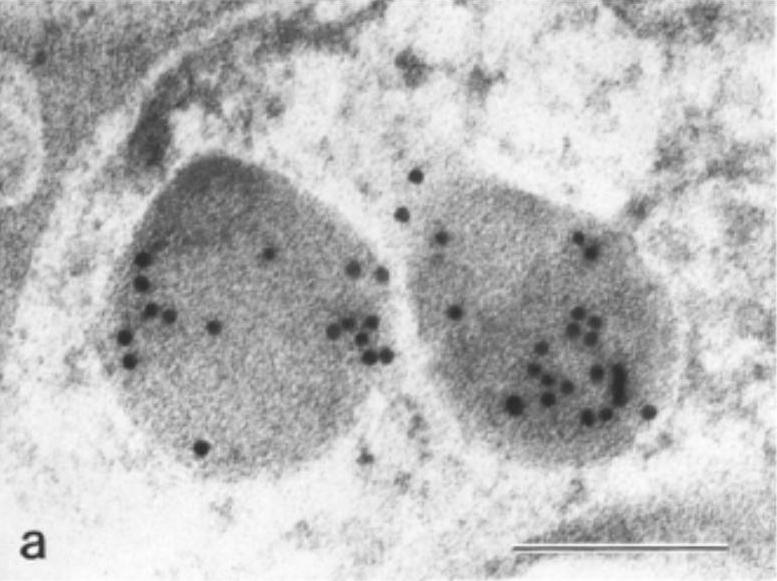
Immunoelectron micrographs confirming localisation of two rhoptry-associated antigens. Bar=0.2 mm. Parasitised erythrocytes were fixed with I% glutaraldehyde prior to embedding in LR White resin. Gold labelling (15 rim) is clearly visible on rhoptry organelles, showing location of QF3. (Mab 7H8/50). Ingram LT, Stenzel DJ, Kara UA, Bushell GR. Localisation of internal antigens of Plasmodium falciparum using monoclonal antibodies and colloidal gold. Parasitol Res. 1988;74:208-15.
See original on MMP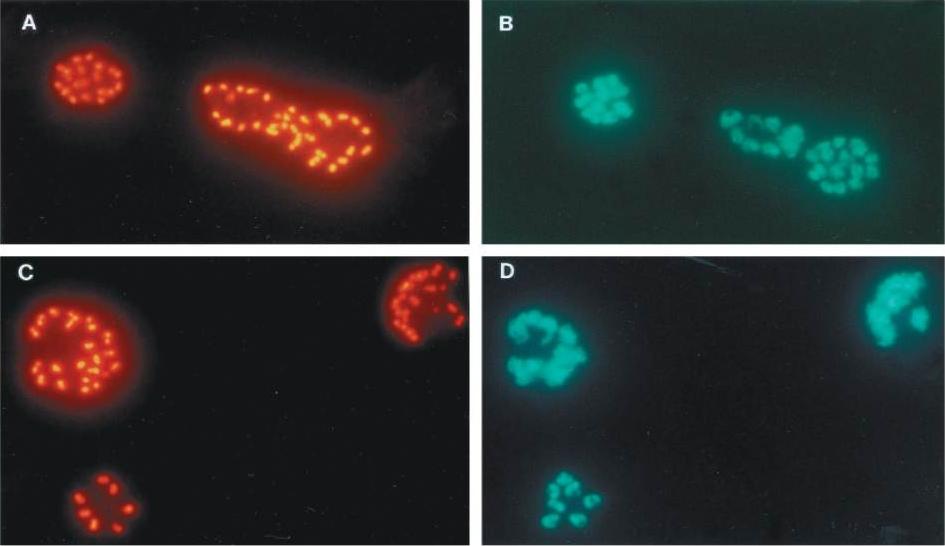
Immunofluorescence staining of mature schizonts of P. falciparum K1 by anti-35.1 MAb SP8.18 (A) and anti-rRAP-123–711 MAb RAP1-14 (C). Both MAbs exhibited a double-dot staining pattern characteristic for rhoptry-associated proteins. Parasite DNA was stained using Hoechst 33258 dye (B and D).Moreno R, Pöltl-Frank F, Stüber D, Matile H, Mutz M, Weiss NA, Pluschke G. Rhoptry-associated protein 1-binding monoclonal antibody raised against a heterologous peptide sequence inhibits Plasmodium falciparum growth in vitro. Infect Immun. 2001 69:2558-68.
See original on MMP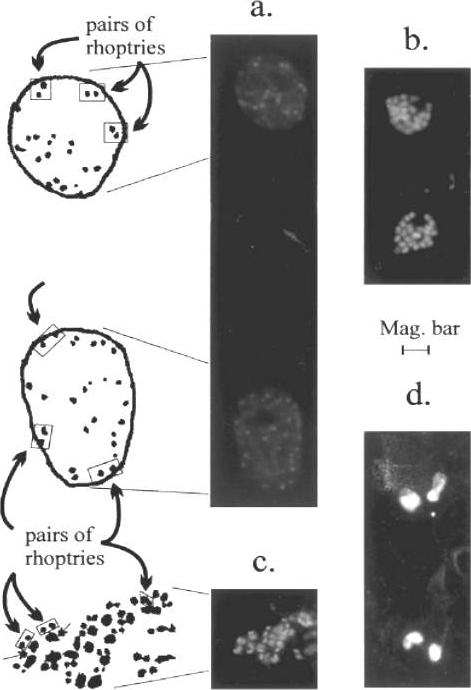
Localization of RAP-1 products in schizonts, merozoites, and rings by IFA. Fixed thin blood smears prepared from synchronized parasites were stained with the indicated primary antibody. Panel (a), schizonts stained with antibody 1E8 reveal many examples of paired organellar antibody localization indicating that the Pr86 epitope is present in the rhoptries. In the artist’s reproduction of IFA images in this panel, six of the many pairs of rhoptries are boxed. Panel (b), merozoites in segmenter-stage schizonts stained with antibody 1E8. Individual nuclei are weakly stained, and there are few, if any, examples of punctate rhoptry staining in intracellular merozoites at this late stage of schizogony. The failure of 1E8 to stain rhoptry antigen in the forming merozoites contrasts with the punctate staining of merozoites by other anti-RAP-1 antibodies (compare panel (b) with (c)). Panel (c), merozoites released from infected RBC and then stained with the anti-RAP-1 mAb 10-8G continue to exhibit a distinct paired spotty or punctate immunofluorescence pattern. Three of the many pairs of rhoptries are boxed in the reproduction to the left of panel (c), and two of the associated stained nuclei are indicated with a double-headed arrow. Panel (d), the anti-RAP-1 mAb 2D9 brightly stains diffusely distributed antigen in ring stage parasites. Panel (a) has twice the magnification of panels (b–d). Magnification bar: panel (a), 2 mm; panels (b–d), 4 mm.Howard RF, Narum DL, Blackman M, Thurman J. Analysis of the processing of Plasmodium falciparum rhoptry-associated protein 1 and localization of Pr86 to schizont rhoptries and p67 to free merozoites. Mol Biochem Parasitol. 1998 ;92:111-22.
See original on MMP
The appearance of Plasmodium falciparum schizonts of the ITO4 line at different times of development. The time of sampling from invasion and the number of nuclei per schizont are indicated. Antibodies to proteins associated with invasion related organelles or the parasite periphery (rhoptries : RAP-1; micronemes: AMA-1, EBA-175; dense granules: RESA; parasite periphery: MSP-1, myo-A) were chosen to follow the development and assembly of merozoites in maturing schizonts.Margos G, Bannister LH, Dluzewski AR, Hopkins J, Williams IT, Mitchell GH. Correlation of structural development and differential expression of invasion-related molecules in schizonts of Plasmodium falciparum. Parasitology. 2004 129:273-87. Copyright Cambridge University Press Journals 2011
See original on MMP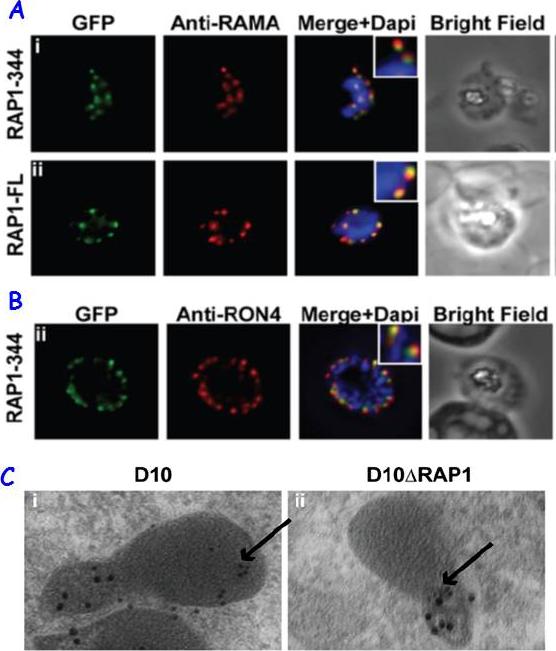
RAP1 contains a bipartite rhoptry signal. A RAP1-344 and RAP1-FL GFP fusions. Both constructs show a punctate fluorescence pattern characteristic of rhoptry localisation. For the RAP1-FL construct, GFP signal overlaps with RAMA. In contrast, the RAP1-344GFP chimera only partially overlaps with RAMA, suggesting rhoptry neck localisation. B. For the RAP1-344 construct, GFP co-localises with the rhoptry neck marker PfRON4. C. Immunoelectron microscopy demonstrates that truncated RAP1 (10 nm beads) in D10DRAP1 parasites is localised in the rhoptry neck, whereas full-length RAP1 in D10 (wild-type) parasites is localised in the rhoptry bulb. PfRON4 PF11_0168 (15 nm beads) is localised in the rhoptry neck in both parasite lines.Richard D, Kats LM, Langer C, Black CG, Mitri K, Boddey JA, Cowman AF, Coppel RL. Identification of Rhoptry Trafficking Determinants and Evidence for a Novel Sorting Mechanism in the Malaria Parasite Plasmodium falciparum. PLoS Pathog. 2009 5(3):e1000328.
See original on MMP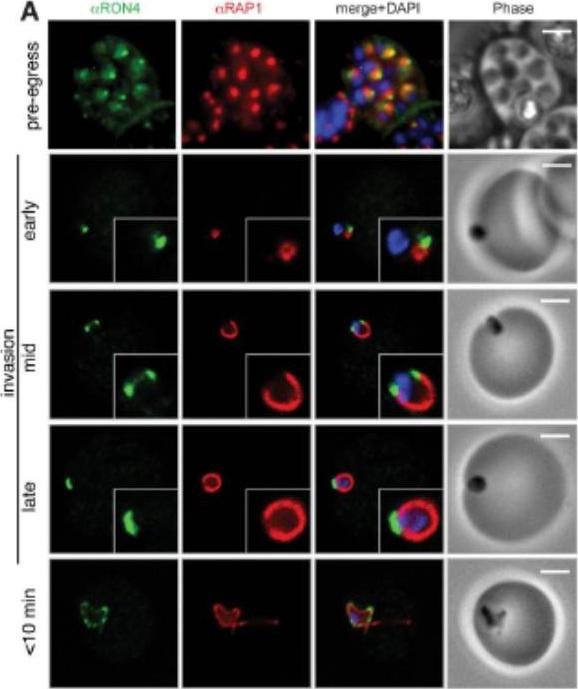
Wide field IFA time course of invasion using A) anti-RAP1/PfRON4. Pre-egress shows standard wide-field image. Invasion images show IFA with deconvolution (single slice). Before invasion commencement, RAP1 clearly remained within the merozoite apex (RAP1 early) posterior to the rhoptry neck as defined by PfRON4. Midinvasion merozoites revealed that RAP1 labeling had moved to an anterior position beginning immediately adjacent to the junction and tracking the exterior of the merozoite as it entered (RAP1 mid). These observations show clearly RAP1 transition pre-, mid-, and postinvasion.Riglar DT, Richard D, Wilson DW, Boyle MJ, Dekiwadia C, Turnbull L, Angrisano F, Marapana DS, Rogers KL, Whitchurch CB, Beeson JG, Cowman AF, Ralph SA, Baum J. Super-resolution dissection of coordinated events during malaria parasite invasion of the human erythrocyte. Cell Host Microbe. 2011 9:9-20.
See original on MMP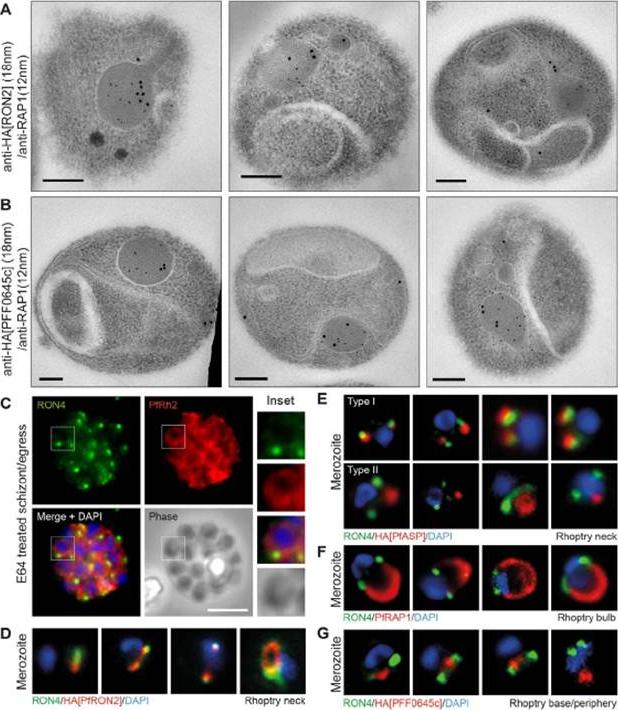
Spatial localisation of different rhoptry proteins before and during merozoite invasion. (A) IEM of free PfRON2-HA merozoites (pre-invasion) dual labeled with immunogold anti-HA (18 nm) and rhoptry bulb marker RAP1 (12 nm). Scale bar = 0.2 mm. (B) IEM of free PFF0645c-HA merozoites (pre-invasion) dual labeled with immunogold anti-HA (18 nm) and rhoptry bulb marker RAP1 (12 nm). Scale bar = 0.2 mm. (C) Widefield IFA of E64-treated schizonts (to prevent egress labeled with anti-PfRh2, anti-PfRON4 and DAPI. Scale bar = 5 mm. (D–G) Independent replicate imaging of merozoites from (D) PfRON2-HA, (E) PfASP-HA (two classes of distribution seen), (F) RAP1 and (G) PFF0645c-HA mid-way through invasion colabeled with anti-PfRON4 and DAPI. RON2-HA is located anterior to the bulb marker RAP1. PFF0645c had a more posterior or contiguous localisation to RAP1, frequently located towards the peripheral regions of the rhoptry.Zuccala ES, Gout AM, Dekiwadia C, Marapana DS, Angrisano F, Turnbull L, Riglar DT, Rogers KL, Whitchurch CB, Ralph SA, Speed TP, Baum J. Subcompartmentalisation of Proteins in the Rhoptries Correlates with Ordered Events of Erythrocyte Invasion by the Blood Stage Malaria Parasite. PLoS One. 2012;7(9):e46160.
See original on MMP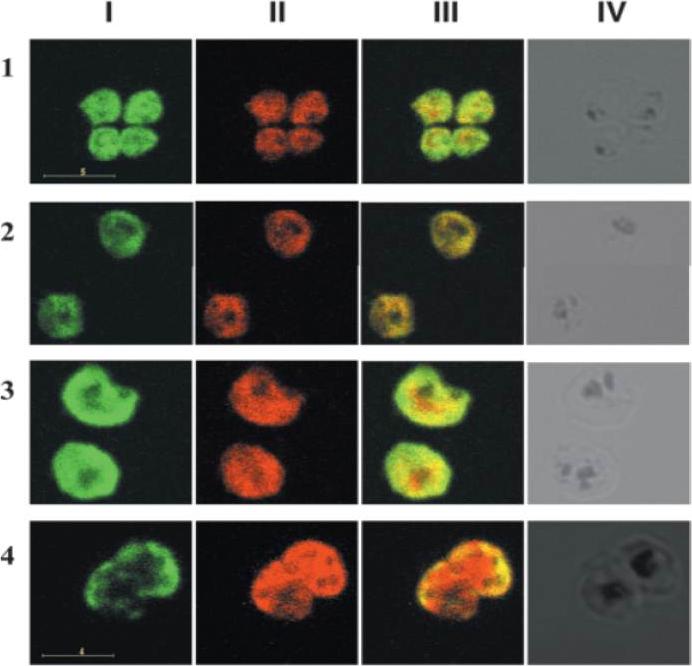
IFA of merozoites stained with a mAb specific for pfGAPDH, pfAldolase and RAP-1. Row 1 demonstrates merozoites stained with anti-pfGAPDH mAb (green, column I), anti-pfAldolase mAb (red, column II) and the overlay of both images (column III). Row 2 shows merozoites stained with anti-pfGAPDH mAb (green, column I) and anti-RAP-1 mAb 5-2 (red, column II) and the overlay of both images (column III). pfAldolase and pfGAPDH were colocalized in the early stages of parasite development since both, the green and the red signals, were super-imposed resulting in orange signals. At 40 h post synchronization the green signal of the anti-pfGAPDH staining was largely confined to the periphery of the schizont, while the red signal of the anti-pfAldolase staining remained distributed equally throughout the schizont. pfGAPDH and pfAldolase were preferentially localized at opposite cell poles. pfGAPDH was preferentially co-localized with RAP-1 which is associated with the apical complex of the merozoites.Daubenberger CA, Tisdale EJ, Curcic M, Diaz D, Silvie O, Mazier D, Eling W, Bohrmann B, Matile H, Pluschke G. The N'-terminal domain of glyceraldehyde-3-phosphate dehydrogenase of the apicomplexan Plasmodium falciparum mediates GTPase Rab2-dependent recruitment to membranes. Biol Chem. 2003 384:1227-37. Copyright Walter de Gruyter GmbH 2009
See original on MMP
The RAP1-35 construct, GFP is trafficked to the PV. RAP1-35-GFP was targeted to the parasitophorous vacuole (PV), the default destination for the secretory pathway, where it is co-localized with SERA5.Richard D, Kats LM, Langer C, Black CG, Mitri K, Boddey JA, Cowman AF, Coppel RL. Identification of Rhoptry Trafficking Determinants and Evidence for a Novel Sorting Mechanism in the Malaria Parasite Plasmodium falciparum. PLoS Pathog. 2009 5(3):e1000328.
See original on MMP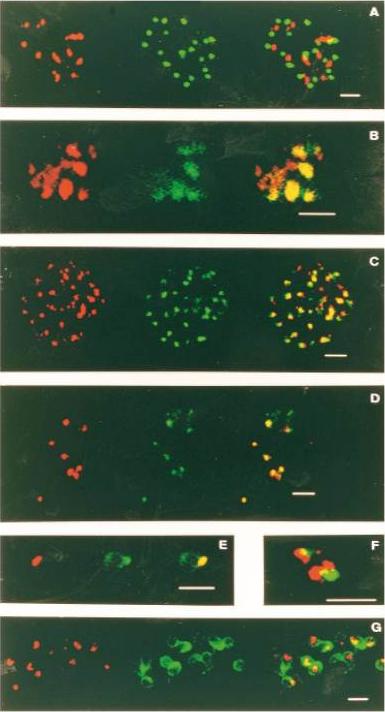
Localization and co-localization of PfPK4, RAP-1, PF14_0102, PF83/AMA-1 PF11_0344 and MSP1 PFI1475w. (A) A segmenter, stained for PfPK4 (red) and RAP-1 (green), with a composite of both labels on the right ; (B) schizont ; (C) segmenter ; (D) and (E) free merozoites, stained for PfPK4 (red) and PF83/AMA-1 (green), with composites on the right ; (F) a free merozoite, a composite of PfPK4 (red) and RAP-1 (green); (G) free merozoites stained for PfPK4 (red) and MSP-1 (green), with a composite of both labels on the right. The scale bars represent 2 mm. PfPK4 distributed throughout the trophozoite, whereas it was found in discrete foci (punctate distribution) in segmenters. PfPK4 co-localizes with AMA-1 at the apical complex in segmenters and merozoites, but does not co-localize with RAP-1.Reproduced with permission, from Möhrle JJ, Zhao Y, Wernli B, Franklin RM, Kappes B. Molecular cloning, characterization and localization of PfPK4, an eIF-2a kinase-related enzyme from the malarial parasite Plasmodium falciparum. Biochem J. 1997 328:677-87. © the Biochemical Society.
See original on MMP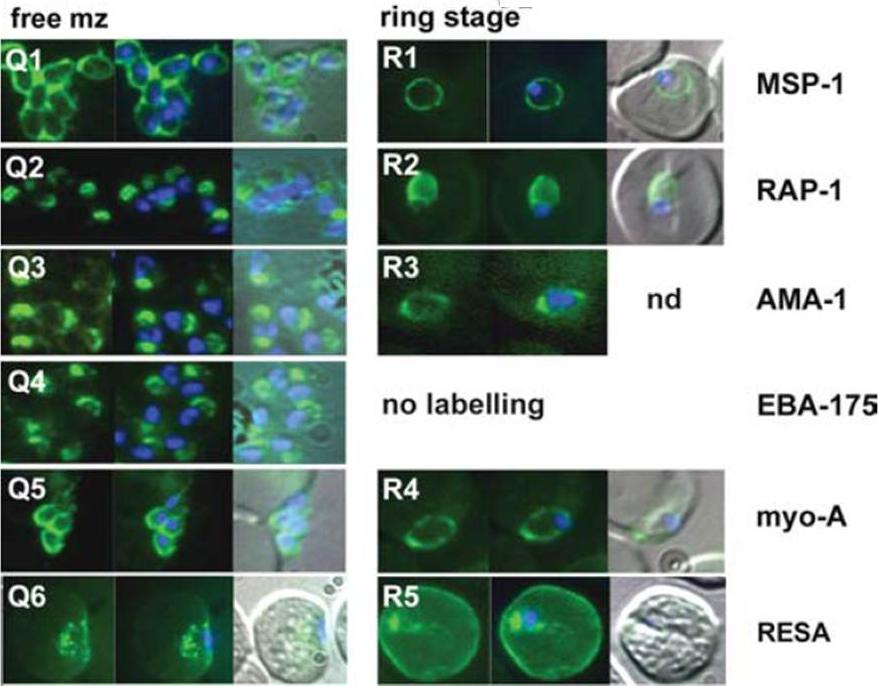
The appearance of Plasmodium falciparum merozoites and rings of the ITO4 line at different times of development. Antibodies to proteins associated with invasion related organelles or the parasite periphery (rhoptries : RAP-1; micronemes: AMA-1, EBA-175; dense granules: RESA; parasite periphery: MSP-1, myo-A) were chosen to follow the development and assembly of merozoites and rings.Margos G, Bannister LH, Dluzewski AR, Hopkins J, Williams IT, Mitchell GH. Correlation of structural development and differential expression of invasion-related molecules in schizonts of Plasmodium falciparum. Parasitology. 2004 129:273-87. Copyright Cambridge University Press Journals 2011
See original on MMP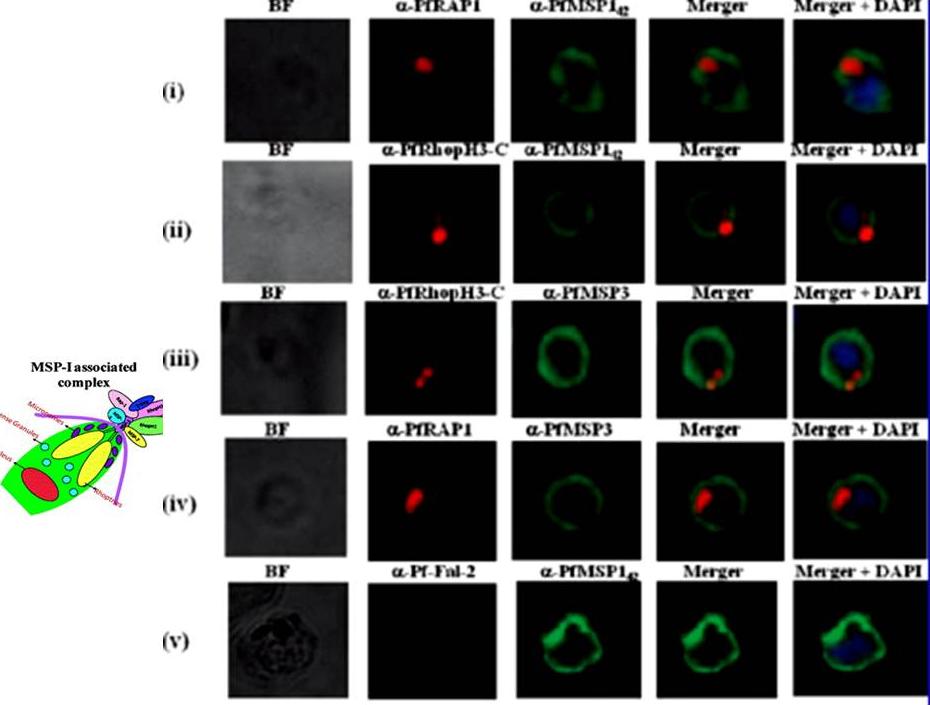
Localization of proteins of PfMSP-1 associated complex by immunofluorescence assay. Unpermeabilized P. falciparum merozoites were coimmunostained with anti-PfRAP-1 and anti-PfMSP-142 antibodies (i), with anti-PfRhopH3-C and anti-PfMSP-142 antibodies (ii), with anti-PfRhopH3-C and anti-PfMSP-3 antibodies (iii), anti-PfRAP-1 and anti-PfMSP-3 antibodies (iv), and anti-Pffalcipain-2 and anti-PfMSP-142 antibodies (v). PfMSP-1 and PfMSP-3 staining was detected on the entire surface of merozoites, while PfRhopH3 and PfRAP-1 staining localized at the apical end of merozoites. Co-localization was observed between PfMSP-1 and PfRAP-1, PfMSP-1 and PfRhopH3, PfMSP-3 and PfRhopH3 as well PfMSP-1 and PfMSP-3 staining was detected on the entire surface of merozoites, while PfRhopH3 and PfRAP-1 staining localized at the apical end of merozoites. Co-localization was observed between PfMSP-1 and PfRAP-1, PfMSP-1 and PfRhopH3, PfMSP-3 and PfRhopH3 as well antibody and the specific location of PfRhopH3 in rhoptries. Ranjan R, Chugh M, Kumar S, Singh S, Kanodia S, Hossain MJ, Korde R, Grover A, Dhawan S, Chauhan VS, Reddy VS, Mohmmed A, Malhotra P. Proteome analysis Rrveals a large merozoite surface protein-1 associated complex on the Plasmodium falciparum merozoite surface. J Proteome Res. 2010 10:680-91. Copyright American Chemical Society
See original on MMP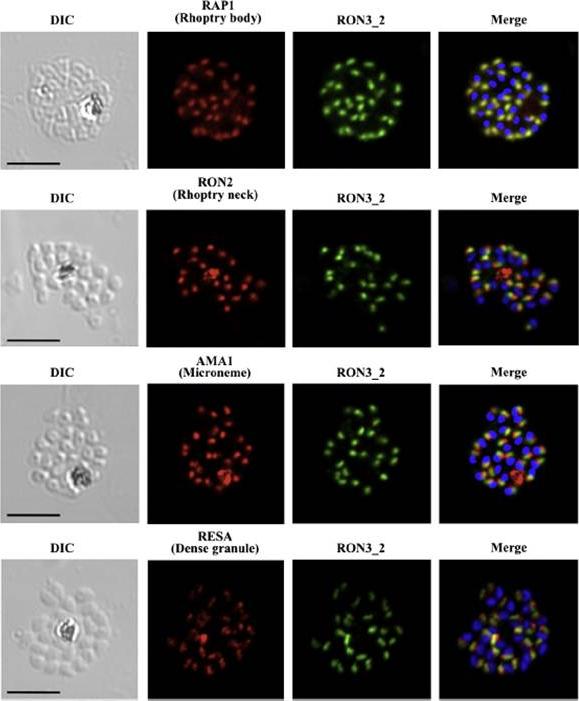
PfRON3 is expressed at the apical end of Plasmodium merozoites. Schizont and merozoite stage parasites were dual-labeled with antisera against PfRON3_2 and either PfRAP1 (rhoptry body marker), or PfRON2 (rhoptry neck marker), or PfAMA1 (microneme marker), or PfRESA (dense granule marker). Nuclei are visualized with DAPI in merged images shown in the right panels. Bars represent 5 μm. PfRON3 is localized to the but in the rhoptry body.Ito D, Han ET, Takeo S, Thongkukiatkul A, Otsuki H, Torii M, Tsuboi T. Plasmodial ortholog of Toxoplasma gondii rhoptry neck protein 3 is localized to the rhoptry body. Parasitol Int. 2011 60(2):132-8.
See original on MMP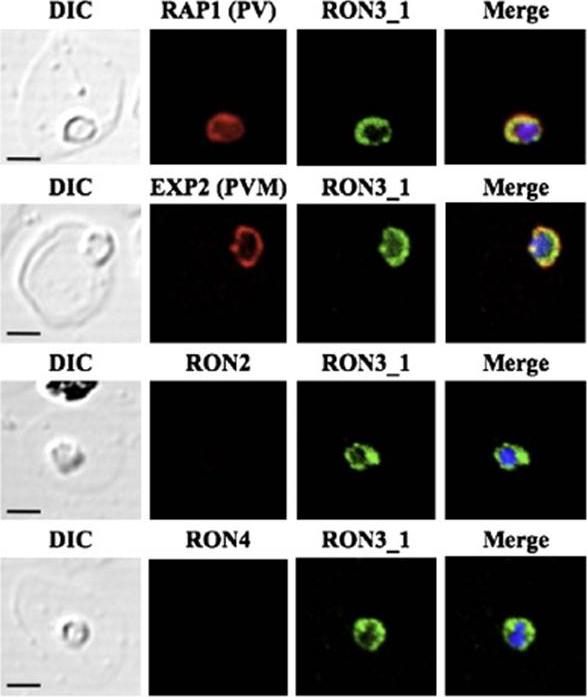
PfRON3 exists in parasitophorous vacuole in ring stage parasites. (A) Ring stage parasites were dual-labeled with antisera against PfRON3_1 and either PfRAP1 (PV marker), PfEXP2 (PVM marker), PfRON2, or PfRON4. Nuclei are visualized with DAPI in merged images shown in the right panels. Bars represent 2.5 μm.Ito D, Han ET, Takeo S, Thongkukiatkul A, Otsuki H, Torii M, Tsuboi T. Plasmodial ortholog of Toxoplasma gondii rhoptry neck protein 3 is localized to the rhoptry body. Parasitol Int. 2011 60(2):132-8.
See original on MMP
Transgenic parasites expressing Pfμ1–GFP were treated with Brefeldin A (BFA) and immunostained with antibodies specific to cis-Golgi apparatus marker ERD2 (i), endoplasmic reticulum marker, Bip (ii), cytoplasm localized, Sel2 (iii) and RAP1 (iv). The Pfμ1–GFP fusion protein colocalized with Sel2 as well as ERD2 in the parasite cytoplasm upon BFA treatment (i & iii). Parasite nuclei were stained with DAPI; scale bars denote 5 μm. Co-localization with antibodies to ERD2 (a cis-Golgi marker) and BiP, as well as the resident rhoptry protein RAP1 and the cytosolic protein Sel2 showed that Pfμ1 did not show a similar pattern as Bip or Sel2Pfμ1 showed a substantially similar staining pattern as ERD2 which is a Golgi marker (i–iii). Pfμ1 also did co-localize with RAP1 in BFA treated parasites (iv). These observations are consistent with Pfμ1 being Golgi associated at this life stage, consistent with its similar dynamics of redistribution upon brefeldin treatment.Kaderi Kibria KM, Rawat K, Klinger CM, Datta G, Panchal M, Singh S, Iyer GR, Kaur I, Sharma V, Dacks JB, Mohmmed A, Malhotra P. A role for adaptor protein complex 1 in protein targeting to rhoptry organelles in Plasmodium falciparum. Biochim Biophys Acta. 2015 1853(3):699-710.
See original on MMP
Confocal immunofluorescence microscopic images of P. falciparum schizonts treated with: Schizonts were stained with DAPI (nuclear stain), Alexafluor-488 (PfRAP1) and Alexafluor-546 (PfCYP19B). White scale bars indicate 5 μM. White arrows show characteristic bi-punctate rhoptry staining. Immuno-staining schizonts for RAP1 under normalconditions resulted in the bi-punctate staining characteristic of rhoptry proteins, while PfCYP19B waslocated in the cytoplasm as expected.Leneghan D, Bell A. Immunophilin-protein interactions in Plasmodium falciparum. Parasitology. 2015 Jul 9:1-11. [Epub ahead of print] PubMed PMID: 26156578
See original on MMP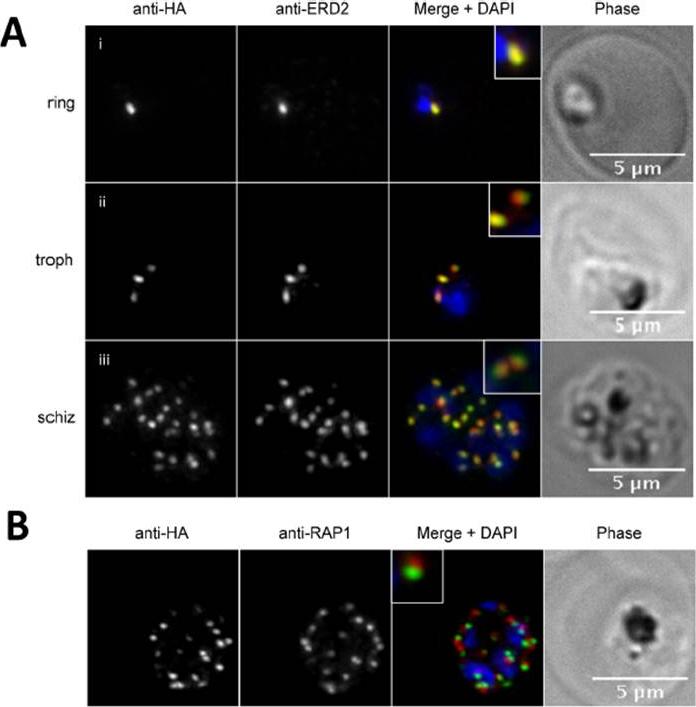
PfPRP2-RFA overlaps extensively with the Golgi apparatus throughout the erythrocytic cycle. (A) In ring stages, PfPRP2-RFA is found as a single punctate pattern colocalizing with the cis-Golgi marker ERD2 (Ai). In trophozoites, prior to nuclear division, the pattern associated with both PfPRP2-RFA and ERD2 becomes triple dots, showing the division of the Golgi, prior to nuclear replication (Aii). In schizont stages, themultiple PfPRP2-RFA signals still colocalize with the cis-Golgi protein ERD2 (Aiii). (B) In mature schizonts, PfPRP2-RFA is found in close proximity but does not overlap with the rhoptry marker RAP1. RAP1, rhoptry associated protein 1. Nuclei of parasites were stained with DAPI (blue). The fluorescence of PfPRP2-RFA is pseudocolored in green and other markers are in red. Scale bar represents 5μm.Hallée S, Richard D. Evidence that the Malaria Parasite Plasmodium falciparum Putative Rhoptry Protein 2 Localizes to the Golgi Apparatus throughout the Erythrocytic Cycle. PLoS One. 2015 Sep 16;10(9):e0138626.
See original on MMP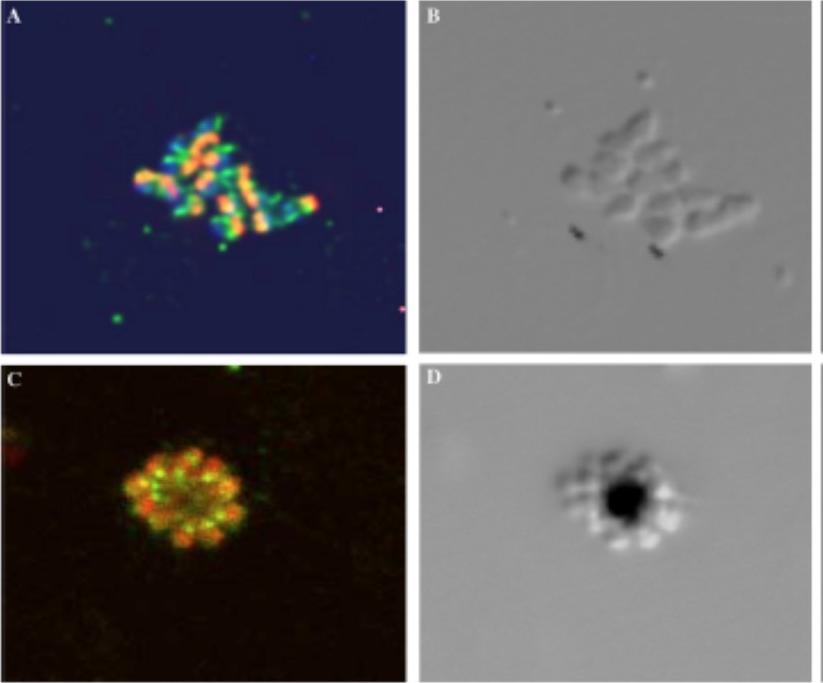
Confocal microscopy demonstrates the location of PfAnkDHHC posterior to apical organelles. (A) 3D7 merozoites were labeled with rat-antiPfAnkDHHC and Alexa-488 conjugated anti-rat IgG (green) and with anti-RAP-1 and Alexa-594 conjugated anti-mouse IgG (red). Nuclei were stained with DAPI and appear blue. (B) DIC image. (C) 3D7 merozoites in schizonts labeled with anti-PfAnkDHHC (green) and a mouse antisera recognizing subtilisin-2 (red). Merozoites attached to the pigment containing residual bodies have their apical end oriented opposite to the residual body. (D) DIC image corresponding to Fig. 2C. All images 630x.Seydel KB, Gaur D, Aravind L, Subramanian G, Miller LH. Plasmodium falciparum: characterization of a late asexual stage golgi protein containing both ankyrin and DHHC domains. Exp Parasitol. 2005 110:389-93. Copyright Elsevier 2010.
See original on MMP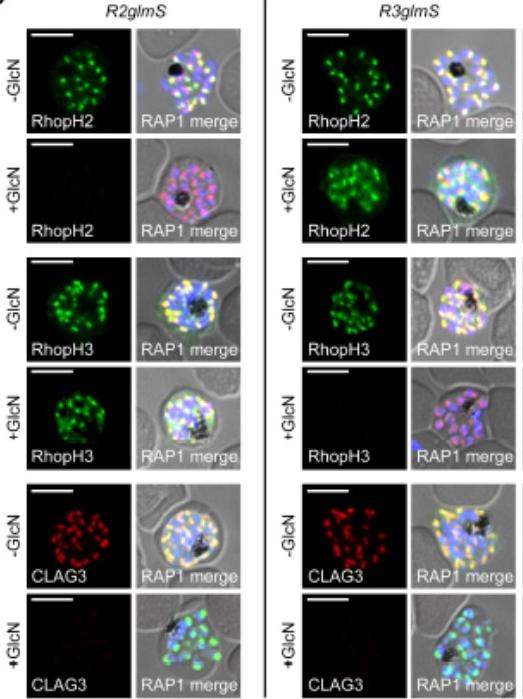
IFA of indicated proteins in R2glmS (RopH2 knockdown) and R3glmS (RopH3 knockdown) at schizont stage; colocalization with RAP1 and apical puncta in daughter merozoites indicates rhoptry trafficking. Scale bars, 5 μm. GlcN treatment of either R2glmS or R3glmS abolished not only the targeted gene product but also CLAG3, a third better-characterized member of the RhopH complex. Indirect immunofluorescence microscopy confirmed this surprising finding and provided additional insights. While RhopH2 was still detected in the R3glmS knockdown, it did not fully colocalize with RAP1 but instead had a more diffuse distribution; this suggests RhopH2 may be retained in the parasite endoplasmic reticulum if it fails to interact with RhopH3. In contrast, RhopH3 appeared to traffic normally inGlcN-treated R2glmS parasites, as indicated by apical colocalization with RAP1 inmerozoites. Thus, CLAG3, RhopH2 and RhopH3 assemble into a complex either during or immediately after translation.Ito D, Schureck MA, Desai SA. An essential dual-function complex mediates erythrocyte invasion and channel-mediated nutrient uptake in malaria parasites. Elife. 2017 Feb 21;6.
See original on MMP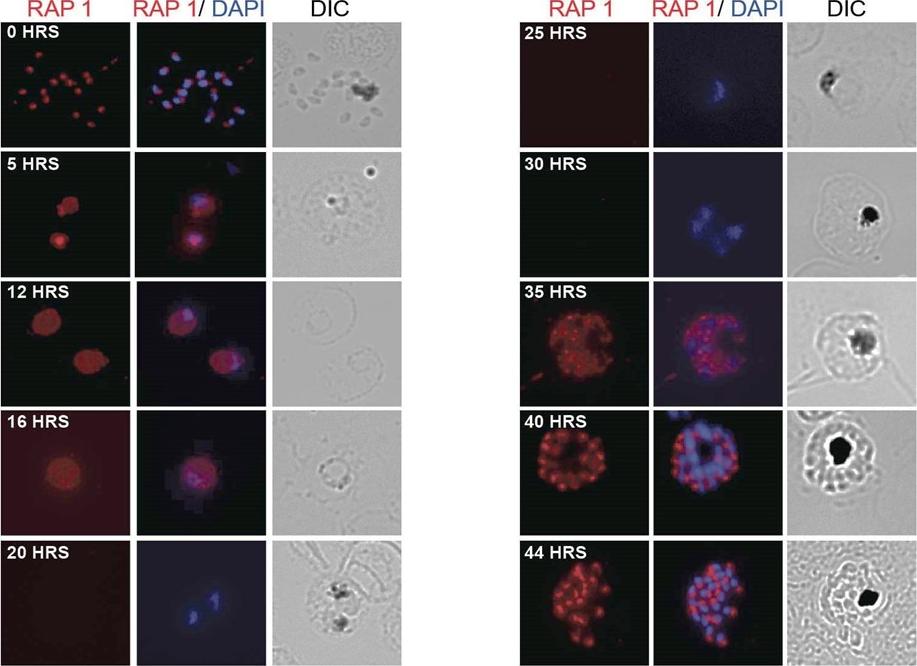
IFA with anti-RAP1 antibody at different time points across the parasite cell cycle shows RAP1 persists up to 15 hrs post-invasion. New RAP1 is not synthesized again until schizont stage when the parasites are beginning to segment. Ghosh S, Kennedy K, Sanders P, Matthews K, Ralph SA, Counihan NA, de Koning-Ward TF. The Plasmodium rhoptry associated protein complex is important for parasitophorous vacuole membrane structure and intraerythrocytic parasite growth. Cell Microbiol. 2017.
See original on MMP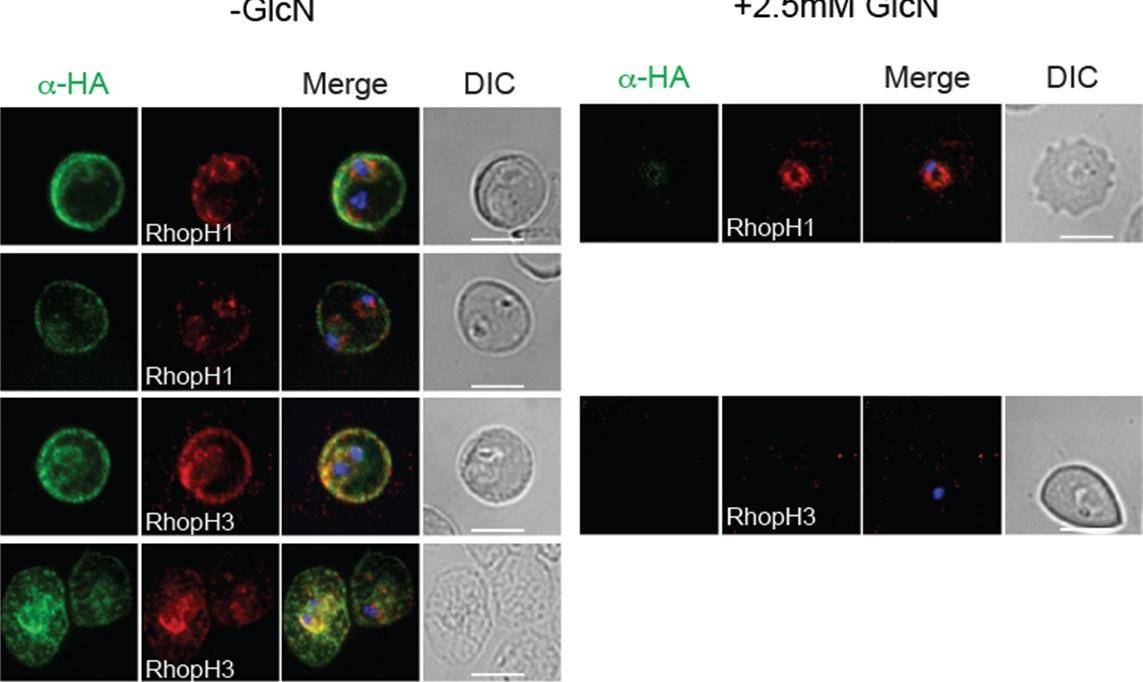
Trafficking of apical proteins is not affected by RAP1 knockdown IFA of schizont stage parasites showing that trafficking of rhoptry (RAMA, RHOPH3, RON6) and micronemal (AMA1) proteins is not affected when RAP1 or RAP2 expression is depleted from parasites with anhydrotetracycline )Atc(. No apparent difference in the electron density or morphology of the rhoptries was observed (Left panel), suggesting that RAP2 is not essential for rhoptry formation in Plasmodium spp. Moreover, knockdown of either RAP1 or RAP2 expression did not affect parasite maturation and replication, as there was no significant difference observed in merozoite number or schizont formation compared to parasites grown in the absence of ATc (right panel).Ghosh S, Kennedy K, Sanders P, Matthews K, Ralph SA, Counihan NA, de Koning-Ward TF. The Plasmodium rhoptry associated protein complex is important for parasitophorous vacuole membrane structure and intraerythrocytic parasite growth. Cell Microbiol. 2017.
See original on MMPMore information
| PlasmoDB | PCHAS_1032900 |
| GeneDB | PCHAS_1032900 |
| Malaria Metabolic Pathways | Localisation images Pathways mapped to |
| Previous ID(s) | PC000272.01.0, PC105913.00.0, PCAS_103190, PCHAS_103290 |
| Orthologs | PBANKA_1032100 , PF3D7_1410400 , PKNH_1347900 , PVP01_1338500 , PVX_085930 , PY17X_1034500 |
| Google Scholar | Search for all mentions of this gene |